China's biggest all terrain vehicle (ATV) producer, Taotao Group Co., Ltd., is searching for overseas acquisitions to promote sales in the West.
Chairman Terry Cao said in an exclusive interview that acquisitions were expected to help enrich the private company's product variety and upgrade technology management. The company was targeting acquisitions of U.S. firms in the same industry, but he would give no other details.
Taotao had maintained 20 percent annual growth in the value of exports since 2006 when its first subsidiary was established in Los Angeles.
"Before 2006, we depended too much on local distributors who held a huge part of the profit," said Cao, adding the company also absorbed the bad debts.
The manufacturer has already established nine wholly owned subsidiaries in the U.S., Canada and Russia. "More than 100 staff abroad are directly in charge of sale and after-sales service in local markets,"he said.
In 2013, the value of exports climbed to 85 million U.S. dollars, while the profit margin has remained around 30 percent for the last seven years.
The U.S. is Taotao's first big foreign market, accounting for 70 percent of its export volume. Taotao holds 70 percent of China's total ATV exports to the U.S..
Last year, it sold 120,000 ATVs and motorcycles in the U.S., where it has 30 percent of the market. It keeps the Taotao brand on 70 percent of products and limits the OEM rate to 30 percent.
The company had anticipated a potential challenge with its limited product structure and brand promotion.
"Our products are still limited to low emission vehicles under 250cc with prices from 300 to 700 U.S. dollars, half as cheap as Honda products," Cao said, "and our customers still are not a majority of American ATV and motorcycle users."
They also had little loyalty to Taotao products.
So on one hand, the company constantly researched and developed high-end products, and on the other, it searched for acquisitions.
Independent R&D was necessary for Chinese enterprises, but Cao argued the process was too slow.
"If we wait too long, our rivals will gain on us," he said.
"The country keeps the GDP growth rate above 7 percent each year. That requires enterprises like us to grow by more than 10 percent a year.
The company expected to boost both sales volumes and brand awareness by purchasing leading established foreign enterprises.
According to Cao's plan, the acquired companies would continue local production in developed markets like the U.S. in the initial stage after the acquisition. But in emerging markets, including Southeast Asia and Eastern Europe, products under the same brand would be made in China.
"Gradually, we will win the midrange and high-end customers' trust."
Taotao was founded in 1985 as a foundry industry. In 1998, it spotted overseas market demand for ATVs and motorcycles, completed a product transition and transformed to an export enterprise. Now its products include electric vehicles, electric bicycles, wooden doors, steel doors, running machines, fitness equipment and garden tools. However, its ATVs and motorcycles account for half of Taotao's overall production value of 165 million U.S. dollars.
Li Jian, researcher at the Chinese Academy of International Trade and Economic Cooperation of the Ministry of Commerce, said Chinese privately-owned firms had often sought acquisitions abroad since the global financial crisis.
"Enterprises engaged in auto parts production in the U.S. were purchased by Chinese private groups who wanted to extend the industrial chain and grow profits," Li said. "It is also a shortcut to build and promote a brand."
Independent R&D took too long for Chinese firms, as foreign competitors had advantages in technology, brands, distribution channels, and the capital to sustain them.
Chinese private enterprises would also effectively avoid trade frictions with acquisitions, Li acknowledged.
However, he warned, Chinese private enterprises had to properly investigate their markets and apply internationally-accepted practices before and during acquisitions, rather than continuing to operate like family-run businesses.
Li said acquisitions would be a fresh driving force for Chinese private businesses with Southeast Asia taking a large number of production orders from Western enterprises.
 简体中文
简体中文



